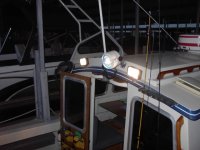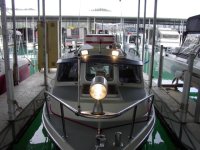I believe that the california boating "law" is "A safe speed should be maintained at all times so that: a) action can be taken to avoid collision and b) the boat can stop within a distance appropriate to the prevailing circumstances and conditions. In restricted visibility, motorboats should have the engines ready for immediate maneuvering. An operator should be prepared to stop the vessel within the space of half the distance of forward visibility.”
Keep in mind that the sailboater on Clear Lake CA.who was at the tiller of the sailboat, drifting, with perhaps improper running lights, is being charged with Manslaughter, when the sailboat was run down by an off duty Sheriff's deputy, who knew the risks of running fast at night, and some folks think was going over 35 mph.
There may be some restricted speeds on specific bodies of water, but to my knowlege California does not have a "speed" limit at night.
As to the planing speed of the Tom Cat--most of us with the Permatrims are able to plane the boat down about 11 to 12 knots--some claim 9 knots (which we have not been able to replicate). 11 knots is a pretty low planing speed.
We have done a lot of boating after dark--most of it in open water. I have made many hundreds of trips to Catalina Island after dark. We generally do not run at a planning speed in the Florida waters, but we do run up Perdido Bay at low planing speeds after dark. This is a body of water we live on, are out on weekly, and rarely has other boats on it--virtually no swimmers, and rare serious debris. We are always running with Radar, chart plotter and fishfinder--NO foreward looking search lights.
We avoided running at at all after Dark except when essential, in the PNW, because of the debris and deadheads. Even with good lookouts and moving at 6 to 7 knots we hit several dead heads in the 3 years of cruising that area. A lot of difference with a full keel, prop protected slow boat, than any C Dory product and its surviability if one hit a deadhead.
We discourage boats running with "headlights". They decrease your distance vision, (such as seeing the tug towing the barge) for dim running lights or other objects on the water, and have very limited range, no matter how bright. They also are confusing to other boaters, as well as decrease the other boater's night vision.
Our personal experience with type I night vision (which we have and use) is not all that good. Even those with the expensive FLIR have found that they can miss deadheads and other debris--and again--they sacrifice their night vision when watching the FLIR screen. If you are going to use night vision--I would suggest that one person's vision be dedicated to the night vision, and the helmsman watch out on the water, and the electronics (Radar, chartplotters and fishfinder). AIS is the latest technology which will help light running--by identifying the vessel using AIS, plus giving its speed, direction and projected track.



